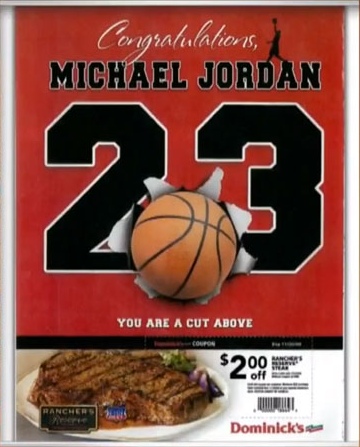On Friday night, a jury in Chicago’s federal courthouse awarded Michael Jordan $8.9 million (of his $10 million claim) for Dominick’s use of his likeness in a magazine ad. The case involved the Illinois Right of Publicity Act and focused on a one-page ad and coupon that appeared in a special commemorative issue of Sports Illustrated sold at Dominick’s grocery stores. Safeway (who owns Dominick’s) reports that only two coupons were redeemed, and its expert opined that damages of, at most, $126,900 would suffice in light of their minimal use.
The award is somewhat curious because Jordan’s damages expert based his $10 million damages claim only on what Jordan would seek, instead of what the parties might agree to in a hypothetical negotiation for Safeway’s actual use. In a Daubert ruling last month, Judge Blakey considered this damages claim, ultimately allowing it. The court explained that Plaintiff argued against the hypothetical negotiation test, claiming that damages should be defined by “fair market value” and that “the fair market value of a property right should not reflect the subjective value placed on that right by a particular buyer.” As such, Jordan’s expert “reviewed Jordan’s actual endorsements (regardless of the context or the usage rights awarded in those endorsements) to calculate the market rate for use of Jordan’s persona as a whole.”
Yet the judge also cited Federal Circuit decisions requiring courts to “consider all evidence relevant to a hypothetical negotiation, as opposed to evidence from one side only.” There appears to be no question that Jordan’s expert did not do this – he apparently did not attempt to gauge whether or not his “comparable” licenses were in fact comparable to this case. In intellectual property cases, generally speaking, federal courts have been incredibly harsh on experts who fail to apply a complete methodology or fail to apply it to the facts of the case at issue. So the big question here is whether or not similar standards apply to the Illinois Right of Publicity Act, which permits an award of “actual damages” without explaining how that should be determined.
So there are a few possibilities here. It would not be surprising to see the judge issue a remittitur, reducing damages to an amount he feels is supported by the evidence. Or if the case goes up on appeal, the courts could decide to apply federal IP case law and remand the case for a new determination of damages. Or of course, the appeals court could determine that the Illinois Right of Publicity Act can permit a relatively one-sided determination of damages, without any need for a hypothetical negotiation.
Either way, I’m not sure we’ve heard the last of this case.
Michael Jordan et al. v. Dominick’s Finer Foods, et al. Case No. 10-CV-00407 (N.D. IL) (Blakey)
